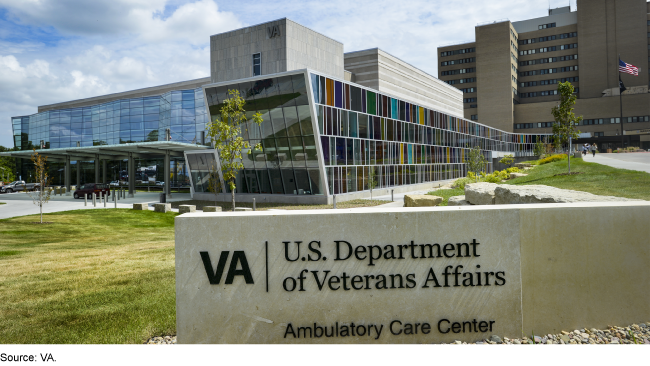VA Health Care Facilities: Leveraging Partnerships to Address Capital Investment Needs
Fast Facts
The VA offers health care services to about 9 million veterans. It operates 171 medical centers and more than 1,100 outpatient facilities. However, VA needs more health care facilities and is struggling to meet its infrastructure needs.
For instance, VA has faced cost overruns and time delays in constructing some facilities. It has also struggled to lease health care facilities; no major leases have been authorized in the last 5 years.
We testified about partnership approaches VA is using to help address its needs, such as accepting facility donations from non-federal entities and integrating facilities with DOD.
VA’s New Ambulatory Care Center in Nebraska was Constructed through a Donation Partnership

Highlights
What GAO Found
The Department of Veterans Affairs (VA) offers health care services to about 9 million veterans at its 171 medical centers and more than 1,100 outpatient facilities. VA has long faced challenges addressing its pressing infrastructure demands. As part of a partnership pilot program, VA is authorized to accept up to five donations of real property—such as buildings, facility construction, or facility improvements—from non-federal entities before the end of 2026. It is also authorized to use certain appropriated funds to help the donating entity finance, design, or construct a facility in connection with its donation. Through this program, VA has received one real property donation—an ambulatory care center in Omaha, NE—and a second—an inpatient hospital in Tulsa, OK—is planned. The Omaha project has provided lessons learned regarding efficiencies of this approach—such as the use of an electronic design-review process—that could benefit future VA construction projects. We identified several considerations that are relevant in seeking additional donation partnerships, such as challenges related to restrictions on which projects are eligible and the sizeable donation required.
Completed Department of Veterans Affairs' (VA) Ambulatory Care Center in Omaha, NE, and Rendering of Planned Inpatient Facility in Tulsa, OK

In 2010, VA and the Department of Defense (DOD) integrated two medical facilities in North Chicago, IL into the Captain James A. Lovell Federal Health Care Center as a 5-year demonstration project. The Lovell Center was intended to create a national model for the joint delivery of health care. It was also expected to inform decision makers about whether this model of care would be effective if replicated at other VA and DOD locations. However, the departments determined that evaluations of the Lovell Center integration did not find that sharing facilities provided benefits over a “joint venture” approach. In a joint venture, the departments share space but manage their operations separately. In part because of the challenges of converting the Lovell Center to a joint venture, in 2016 VA and DOD jointly recommended continuing the Lovell Center's operation as an integrated facility with periodic reviews and implementation of the recommended improvements.
Why GAO Did This Study
VA administers one of the largest health care systems in the nation. VA estimates that fulfilling all of its priority infrastructure projects would cost approximately $63-$76 billion as of fiscal year 2021. GAO has reported that VA has struggled with instances of cost overruns and time delays in constructing some facilities. VA has leveraged partnerships to address its capital needs, including a donation partnership with the private sector (known as CHIP-IN) and an integrated health care facility with DOD.
This statement discusses (1) VA's donation partnership pilot program, efficiencies identified, and considerations relevant to seeking additional donation partnerships, and (2) VA's and DOD's integration of their health care facilities in North Chicago, IL and the agencies' observations on the integration. This statement is based on GAO's prior work.
Recommendations
GAO has made recommendations to VA regarding the use of leading practices for pilot programs (GAO - 19 - 117) and a lessons-learned process for the donation partnership projects (GAO-21-133). VA concurred with and implemented these recommendations.
GAO also recommended that VA and DOD collaborate to update a cost- effectiveness analysis for the Lovell Center (GAO-17-197). VA and DOD concurred with and implemented this recommendation.
